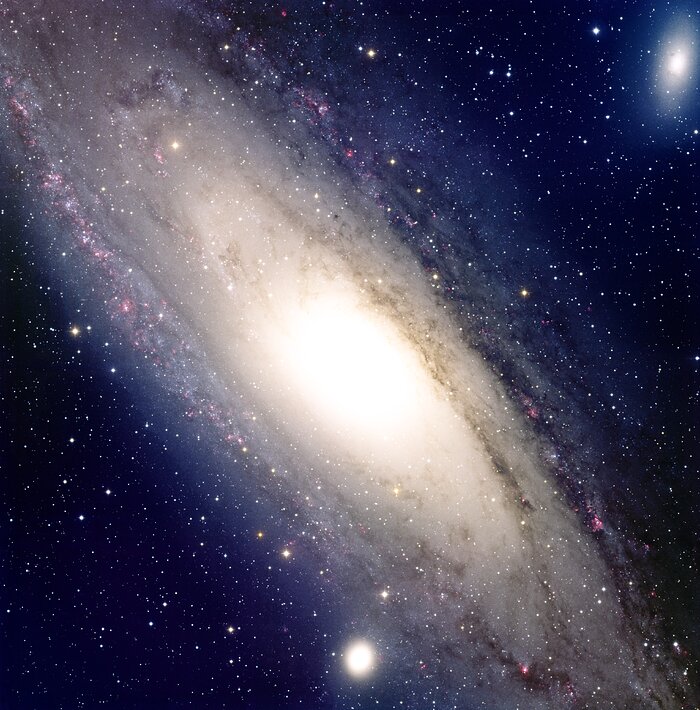
Caption: "This detailed image of the Andromeda Galaxy (M31, NGC 224) was taken at the National Science Foundation's (NSF) 0.9-meter telescope at Kitt Peak National Observatory (which is on Kitt Peak) with the NOAO Mosaic CCD camera." (Slightly edited.)
-
Features:
- The Andromeda Galaxy is located in the constellation Andromeda.
- It is a large spiral galaxy rather similar to our own Milky Way (AKA the Galaxy).
- Distance: 0.778(33) Mpc (2.54(11) Mly).
- Size scale: ∼ 70 kpc (∼ 220 kly).
- Apparent size: 3.167° X 1°. This is really very large. Recall the Moon's angular diameter is 0.5178° (see Cox-16,303,305; Wikipedia: Moon: Appearance from Earth). The area shown in this image is quite large on the sky since the length scale is ∼ 6 times that of the full moon.
- "This true-color image was created by combining images taken in 7 filters: the UBVRI filters: main bands ultraviolet, blue, green, red, infrared, Hα (narrow red), oxygen [O III] (narrow green)." (Somewhat edited.) Actually, yours truly thinks the image is enhanced true-color: i.e., colors are brighter than what the human eye would see.
- The Andromeda Galaxy M31 is visible to the naked eye as a cloudy star under dark sky conditions. It also just appears as a cloudy star in small telescopes. What one sees essentially is the bright central galactic bulge. The spiral arms are relatively faint and can only be seen by high sensitivity imaging or in visual astronomy with a large primary (i.e., one ∼ 1 m in diameter).
- Note, most of the star-like astronomical objects seen in this image are foreground stars in the Milky Way. There are two dwarf-galaxy satellite galaxies of the Andromeda Galaxy and there may be some globular clusters in the Andromeda Galaxy.
- The Andromeda Galaxy is in the Local Group of Galaxies and is the nearest large galaxy to the Milky Way. It is approaching us at 266 km/s and according to recent calculations has ∼ 50 % chance of galaxy merger with the Milky Way on the time scale of 8 gigayears (Gyr) (Sawala 2024, "Apocalypse When? No Certainty of a Milky Way -- Andromeda Collision, p. 4). If there is NO galaxy merger on this time scale, the Andromeda Galaxy and Milky Way will NOT merge (Sawala 2024, "Apocalypse When? No Certainty of a Milky Way -- Andromeda Collision, p. 4), except by wild extrapolation of the Λ-CDM model on the time scale of 10**6 = 10**15 years (Wikipedia: Graphical timeline from Big Bang to Heat Death (but note that the left-hand vertical scale is tricky for > 10 years: it is x=100*log(log(t_year)), and so t_year=10**(10**(x/100)) ). See the possible Andromeda-Milky Way collision video in galaxy videos below (local link / general link: galaxy_videos.html):
Credit/Permission: ©
T.A.Rector, B.A.Wolpa, NOAO/AURA/NSF,
NOAO /
AURA /
NSF,
before or circa 2003 /
NOAO/AURA Image Library Conditions of Use.
Image link: NOAO Images:
The Andromeda Galaxy.
Local file: local link: galaxy_andromeda_m31.html.
File: Galaxies file:
galaxy_andromeda_m31.html.